
Boeing 737-800 cockpit.
Ok, so sue me...the title of this post is a gross exaggeration. The truth is that I don't hate the 737 at all, but with a few hundred hours under my belt, the honeymoon is officially over and my eyes have been opened to a few of this jet's shortcomings.This isn't an Airbus vs. Boeing post, so I'll leave my feelings about Airbus philosophy to your imagination. I won't comment on "plastic jets" and computers that isolate pilots from the decision making process. I won't even hint at the common assertion that Airbus planes are designed for the lowest common denominator of pilot skill. Forget about the tail that snapped off an A300 over New York or known pitot tube failures on the A330. Those subjects are completely off limits. My lips are sealed!
After all, talking badly about a man's airplane is a little like taking badly about his children. My kids may be rotten to the core (I promise they aren't...most of the time anyway), but while I'm allowed to say so you, most assuredly, are not. My airplane is no different. I have no tolerance for an Airbus guy talkin' smack about my Boeing and choose to respect my fellow bus buddies by holding my tongue on the subject of their precious Fifi.
All you bus lovers can put your pens down and save your angry letters for another day, this post is intentionally sarcastic. If I can poke a little fun at my own ride then I'm going to take a few pot shots at the Airbus too. Oddly enough, most of the Boeing hater's complaints about my airplane are related to the things I value most. One of my favorite bus pilots recently told me that he could "always turn the magic off and have a basic, 737 dinosaur." I took his comment the way I think it was intended, tongue-in-cheek, but again, his complaint is exactly what I love about the 737.
There's a huge philosophical difference between the way these two companies design airplanes. Boeing airplanes are designed to defer to the knowledge, skill and experience of the pilot (sometimes to a fault), while Airbus relies heavily on computer systems (sometimes to a fault) that can override actions taken by the pilots...which is clearly a valuable safety system to protect against pilot error (think Asiana 214). The problem in my mind is the old computer adage "garbage in garbage out" (think AF447 and iced over pitot tubes).
Up until now, I've basically stood on the side lines of this debate as I spent most of my airline career at the controls of an MD80...another airplane people either love or love to hate. I believe I've mentioned this before, but my father, a long time Boeing guy, warned me not to spend too much time on the 80. "You might decide you like it" he used to tell me. Well apparently, I stayed too long, because after 13 years and 9,000 hours I grew to love flying the MD80, which flies the way I suspect a 40 year old Mack truck might drive...heavy on the controls, manual everything and loud enough to wake the dead. What's not to love?
Good ole dad was pleased with my decision to ditch the Douglas and I have to admit, I've become quite comfortable at the controls of the Boeing 737 and will avoid going back to the 80 if at all possible. (Currently, MD80 captain looks like it will be my first opportunity to shed my twitter name: @AAFO4Ever). But as much as I enjoy flying the 737, I have identified a short list of the items that could have been done much better.
An overhead panel only it's 100 year old creator could love.
The overhead panel on the 737 is, in my humble opinion, the most egregious design deficiency on the whole airplane and it's the obvious answer to the question "What do you hate about the airplane?" I got my 737 type rating in 1996 in an almost 30 year old 737-200 flight simulator. The airplane was equipped with round dials and steam gauges galore. In the 1980's, Boeing introduced the 737-300, 400 and 500, commonly known as the Boeing Classic Series, that came with advancements in engine and wing design while the overhead panel remained basically unchanged. Then came the "Next Generation" airplanes, the 737-600, 700, 800 and 900, with a new wing, updated engine and a glass cockpit. Why they chose to keep the old overhead panel is a question that boggles my mind and ticks me off. The top of my bald head is marred by dents, scratches and bruises left by an overhead panel that is virtually identical to that old -200 I flew in 1996...a design from the late 1960's.
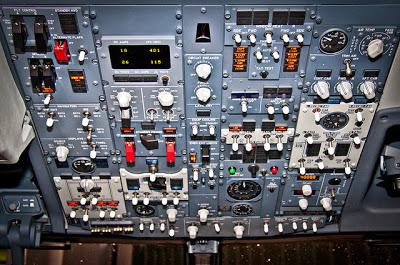
There's a familiar old rumor that the 737 overhead panel remained unchanged at the insistence of a well known Texas based low cost carrier...use your imagination...who even programmed their flat panel instrument screens to approximate the look of an old "six pack" arrangement. All this done in an attempt to keep its fleet of Boeing 737 cockpits looking as similar as possible. I've never been able to officially confirm that as fact, so take it with a grain of salt.
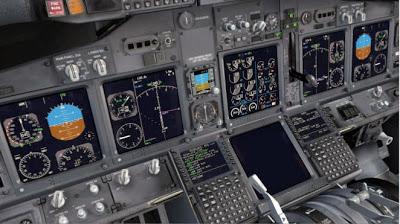
Boeing 737-700 instrument panel set up to look "classic"
That infernal trim wheel.
Most small airplanes have them. Most large airplanes don't. I hate it when bad or unnecessary design elements of older jets find their way into the cockpits of their modern counterparts. The 737 trim wheel is a prime example. A direct carry over from the 707 that ushered in the jet age in the 1950's, the maddening, knee cap busting, noisy and hyperactive trim wheel on the 737 should have departed the cockpit long ago. I suppose there is someone out there who has actually used it in an emergency, but there are plenty of examples of great jets...the Boeing 757,767, 777, 747 and 787 to name a few...flying around without them.
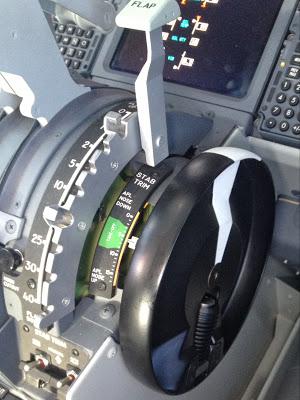

Did I mention knee cap busting? The handle pictured above is used in the event of a failure of the electric trim system. It serves an obvious purpose, but if you make the colossal mistake of extending the handle and consequently forget to stow it after electric trim is restored, a visit to the emergency room may be in order.
Go around! Wait...where are the TOGA buttons?!?
As if go-arounds weren't confusing enough, Boeing decided to have a little fun at the expense of the pilots and hid the TOGA buttons on the 737. Basically speaking, there are two opportunities to push the TOGA buttons on every flight. First, during takeoff and second, in the unlikely event of a go-around.
When cleared for takeoff, the pilot will push the thrust levers up far enough to stabilize the engines at about 40% N1, then push either or both TOGA buttons to automatically advance the engines to the takeoff limit and engage the Automatic Flight Director System (AFDS) in takeoff mode. Once airborne, pushing either of the TOGA buttons will advance engine power to the go-around limit and engage the AFDS in the go-around mode.
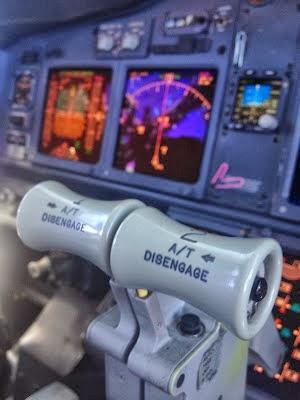
Only one visible in this picture...the small black button
hidden underneath the throttle knobs.
Is your FMS smarter than a 5th grader?
I could write a lengthy how-to book explaining the ins and outs of the Boeing 737 FMS and I could write an equally long book on the pitfalls of this "box" and how it could have been better. You have to watch it like or a hawk or it will bite you in the butt. The FMS is an integral part of the 737, containing the various functions of ACARS, departure, en-route, arrival, approach and navigation data in addition to weight and balance, altitude capability and engine performance information. There's more, but those are the biggies.
One of my chief complaints is that the FMS is slow...like Commodore 64 slow. I constantly find myself pushing a button and counting to three so the darn thing has time to think before I ask it to do something else. Most of the boxes I've used in the past would allow the pilot to get ahead of the FMS. There are certain processes we do all the time...we get used to the sequence of buttons to be pushed and can get ahead of the box pushing buttons that aren't yet prompted. The 737 FMS won't allow you to do this. Push a button...count to three...let it think...let it respond...push another button. It's like molasses in the winter...thick and slow.
I suppose I shouldn't complain. At least I have an FMS, but I spend a fair amount of time in the cockpit with pilots who used to fly airplanes like the Boeing 757, 767 and 777. All those pilots would like to know why the 737 FMS is so much different than the rest. It get's overly confused in the descent if any changes are made to the profile after the Top Of Descent. It has a tendency to change or ignore climb and descent speeds. And there is simply too much slop when it comes to airspeed in general. If I command a 300 knot descent then that's what I want...not 290...not 315...300! It tends to the same thing in straight and level flight as well. ATP standards require me to maintain airspeed within 10 knots and I expect the automatic systems of the jet that are supposed to make me look good and simplify my job to do much better than barely meet the minimums.
An autopilot disconnect warning heard from the aft lav!
Oh my goodness, what were they thinking? Every other airplane I've ever flown had an autopilot disconnect warning that consisted of a red or yellow flashing light and or a reasonable sound to get your attention. The warning sound on the 737 seems to be designed to wake you from a deep sleep...while seated somewhere deep inside the coach cabin. It is unnecessarily loud and sounds much longer than needed or desired. On most planes, one push of the autopilot disconnect switch disconnects the autopilot while the second push of the same switch cancels any and all warnings. On the 737, that infernal noise continues through three cycles no matter how fast you push the disconnect button. It's so loud, that I usually warn the other pilot that it's about to sound and do my best to time the disconnect so that it doesn't interfere with any expected radio transmissions.
Kit bag storage
This one has been mitigated by advances in Electronic Flight Bag technology, but I still need to get into my flight bag every now and then and would prefer not to wrench my back trying to reach it. Next to my seat, where my kit bag should reside, is an oxygen mask, a cup holder and a lot of wasted space. Plain and simple, this is a poor design. See if you can find a place for your bag in the pic below.
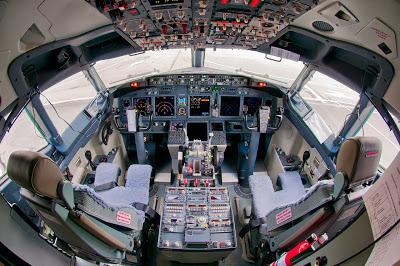
Approach speed...will this thing ever stop?!?
Some 737's are worse than others. I fly the 800...the 900 would be even worse. With an extended fuselage on an airplane that already sits fairly close to the ground, approach speeds have to be much faster to prevent the tail from contacting the runway during flare. As you might imagine, this is also a significant concern during takeoff.
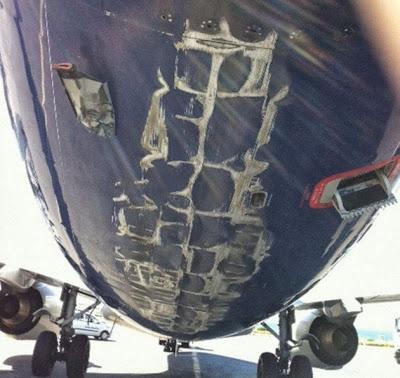
When tail meets runway.
As an MD80 pilot, approach speeds were typically in the neighborhood of 135 knots. On the 737, I regularly see approach speeds around 150. The airplane has excellent brakes and ground spoilers help it stay on the ground after landing, but that extra 15 knots is not a good thing when landing on short, wet runways.A good airplane that could have been better.
I grew up in a house that lived by the motto "If it ain't Boeing, I ain't going." So after 13+ years flying McDonnell Douglas planes around the US, Canada and Mexico, I'm happy to be living by the family creed. I wish the 737 was a better plane, but I'm a firm believer in the philosophical design choices made by Boeing and I'm happy to be flying around with something between my legs. Still...it could have been better. Even so, I choose Boeing over Airbus any day.
Let the hate mail flow!


posted on 15 February at 10:56
As a (FSX PMDG)simulator flyer/ cockpitbuilder. I love the 737NG. Its a combination of classic and modern.